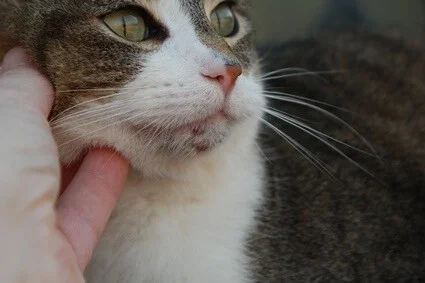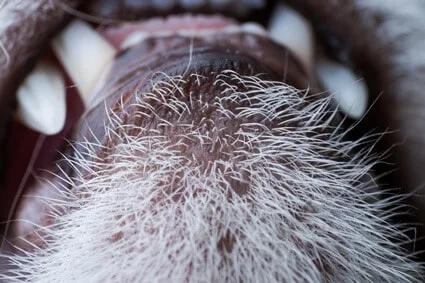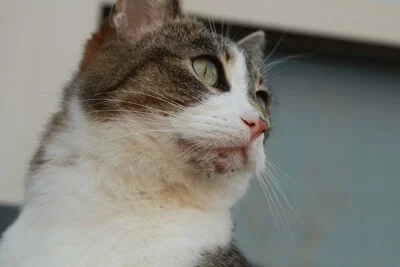Acne on the chin is among the most common skin conditions experienced by cats. Usually, feline acne will manifest as small, subtle whiteheads or blackheads. Eventually, left untreated, it can turn to large, unsightly pimples and pustules.
Feline acne isn’t contagious. However, several cats that live in close proximity can experience acne outbreaks, so one common cause will be to blame. This may be dirty water, shared allergies, parasites, or contagious infections.
Just because feline acne isn’t contagious to other cats doesn’t mean that it should be ignored. Even if your cat seems comfortable or indifferent, you still need to identify the cause.
What Is Feline Chin Acne?
Acne will manifest as small, bumpy whiteheads or blackheads on a cat’s chin. If allowed to persist, these will evolve into pimples. Eventually, these pimples will burst, resulting in infection and bleeding.
The Japanese Journal of Veterinary Dermatology studied 74 cases of feline chin acne, finding the condition to be indiscriminate. Any cat can develop chin acne, regardless of age, breed, or sex. It is often linked to other issues.
Some cats develop a solitary bout of acne and quickly recover. Others can experience regular outbreaks.
Can Chin Acne Be Passed Between Cats?
Acne on the chin is a unique problem, personalized to the individual cat. This means that cats cannot pass acne between themselves through proximity. It is not a contagious health issue.
Despite this, cats that live in close proximity can all develop acne, seemingly simultaneously. This is not due to contagion. It suggests that all cats have the same cause for an acne outbreak.
If one cat develops acne on its chin, it may just be unfortunate. This is especially true in young cats that experience floods of hormones akin to puberty. If several cats are all experiencing acne, there will be a reason.
Causes of Feline Chin Acne
Feline chin acne is caused by an excess of keratin in the cat’s skin. This is a protein that causes blockages in the pores. It’s also possible for medical or lifestyle-based concerns to be factors, especially if several cats are affected.
Allergies
As reported in The Feline Journal of Medicine and Surgery, Cornell University studied 1,407 cases of feline acne over 15 years. While a varied list of explanations was found, allergies were the most common cause.
Many cats are allergic to plastic, meaning that their food and water bowls could be to blame. When a cat eats and drinks from such a vessel, it rubs its chin against the surface. This can cause an outbreak of acne.
Your cat’s food may also be to blame. If you have recently changed its food brand and acne has followed, this is likely as cats can be sensitive to dietary changes. Offer your cat a bland meal, such as chicken and rice, and see if this helps.
Stress and Anxiety
If your cat is stressed, it will undergo behavioral changes. Chief among these is excessive grooming, or none at all. Excessive grooming will agitate the skin, while no grooming will lead to oily and greasy fur.
In addition, stress will flood a cat’s body with hormones. This can lead to an eventual imbalance. Acne is just one of the side effects of this. Manage your cat’s stress levels by assigning a routine and avoiding trauma.
Dermatitis
Some cats may experience dermatological concerns, leading to chin acne. These issues may be hereditary, passed down from parents. This makes outbreaks of acne among littermates likely. Veterinary Dermatology lists domestic mixed, Abyssinian, and Devon rex breeds as the most likely to suffer.
Dermatitis can also be caused or worsened by hormonal fluctuations. When a cat enters its senior years, hormone levels should have leveled out. However, surges and drops in hormone levels are always a possibility.
Parasites
If a group of cats live together, a parasitic outbreak will quickly spread. Fleas will infect multiple animals at once. These parasites can also be an explanation for chin acne. An allergic reaction to flea saliva may cause acne.
Ringworm
Ringworm is a viral skin condition that is contagious among cats. If one cat develops ringworm, any animal it encounters will likely develop it.
Ringworm causes flaking, cracking, and peeling skin. It can also lead to sores and scales that can sometimes be mistaken for pimples. The longer a cat lives with ringworm, the more uncomfortable it will become.

Mange
Mange looks similar to ringworm. This issue is caused by burrowing mites that feast on a cat’s dead skin. Like ringworm, this will damage skin and lead to acne or worse. Most topical treatments that kill fleas will kill mites.
Viral or Bacterial Infection
Acne can be a side effect of a viral infection passed between cats. While acne alone is not contagious, feline herpesvirus (FHV) or feline calicivirus (FCV) spread like wildfire. They will reduce the efficacy of a cat’s immune system.
Other, more serious bacterial infections can also spread among cats. Staphylococcus aureus, aka a staph infection, is concerning. If one cat has acne and other symptoms of ill health, you should isolate it from others.
Check the water supply that your cats drink from, especially it is shared. A communal outbreak of chin acne can suggest bacteria in the water. This can be common in areas with hard water.
Acne caused by water is even more likely in outdoor cats. Felines often eschew tap water for wild sources, including puddles or rivers. These bodies of water may contain bacteria. Keep your cats indoors and offer other water sources.
Substandard Hygiene
If your cat is not grooming itself enough, its skin and fur will become increasingly oily. This will lead to inflammation of the cat’s hair follicles, and acne will follow.
Senior cats, in particular, can struggle to groom properly. Feline bathing requires agility and flexibility, and many older cats become arthritic. You may need to assist your cat with its grooming regime.
Excessive Rubbing of The Chin
Consider whether your cat is simply rubbing its chin to excess. Cats have scent glands in their chin, which they use to mark territory. A cat that marks constantly will wear away the fur around its chin. This exposes a cat’s delicate skin, making acne increasingly likely.
Assign your cat its own unique and undisputed territory. This will reduce the desire to mark other parts of the home. If the cat persists in chin-rubbing, apply as many soft furnishings as possible to reduce the impact.
Is Acne Painful for Cats?
Chin acne can be asymptomatic. The issue is unsightly but not painful or dangerous. All the same, an explanation for feline chin acne merits investigation. Acne can turn into pimples, which can become irritable and inflamed.
If a cat has pimples, it will likely scratch at them. As cats have sharp claws, this will open wounds. Once this occurs, bacteria can gain access to your cat’s skin.
While your cat may appear indifferent to whiteheads or blackheads, this can change overnight. Do not ignore the initial signs of the problem. If you take early action, your cat will be more comfortable.
Never squeeze and pop a pimple on a cat’s chin. This will cause significant pain and distress to the cat. What’s more, it will create an open wound that may invite further infection.
Treatment for Feline Chin Acne
Prevention is always the best remedy for feline chin acne. If the problem does manifest, various treatments are available. The solution you choose should be tailored to the cause of the issue.
Regular Washing
If your cat is older, it will struggle to groom itself appropriately. This may include the chin and face. Combat this by assisting the cat with its grooming regime. Keep a cat’s fur around the chin short, too. At least once a day a week, wash your cat’s chin with a soft washcloth. Always use plain, unscented soap.
Changes to Food and Water Bowls
As discussed, plastic allergies can be a major cause of feline acne. If several different cats eat and drink from such vessels, communal acne is likely. Switch plastic bowls for metal or ceramic alternatives. Alternatively, in the case of food, remove bowls altogether.

Dietary Changes
Ensure that food is not causing acne. If your cat primarily eats wet food, steadily introduce more kibble or vice versa. In persistent and troublesome cases of acne, the cat should be switched to an anti-inflammatory diet. Older cats also need less protein, which means they’ll produce less keratin. Switch your cat to senior-specific cat food.
You could also consider introducing supplements to your cat’s diet. Omega-3, in particular, is considered effective against feline chin acne. Consider switching to bottled water or using a water fountain.
Topical Treatments
Rubbing a topical remedy under a cat’s chin can soothe folliculitis. Treatments include:
- Green tea
- Apple cider vinegar (virgin and cold-pressed)
- Coconut oil
- Witch hazel
- Cucumber pulp
If these homeopathic remedies are ineffective, consult a vet. Your cat may have a skin condition or hormonal imbalance that requires treatment. Where possible, a topical ointment will be prescribed.
A cat with chin acne will not pass the condition on to other felines. This doesn’t mean that a group of cats cannot all contract acne, though. There will be a shared experience causing your cats to develop acne.

